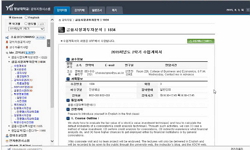In this paper, we adopt the MF-DCCA (Multifractal Detrended Cross-Correlation Analysis) method to study the nonlinear correlation between the returns of financial stock mar- kets and investors’ sentiment index (SI). The return series of Shanghai Sec...
http://chineseinput.net/에서 pinyin(병음)방식으로 중국어를 변환할 수 있습니다.
변환된 중국어를 복사하여 사용하시면 됩니다.
- 中文 을 입력하시려면 zhongwen을 입력하시고 space를누르시면됩니다.
- 北京 을 입력하시려면 beijing을 입력하시고 space를 누르시면 됩니다.
https://www.riss.kr/link?id=A109276125
-
저자
RUI ZHANG (SCOOL OF COMPUTER, QINGHAI NORMAL UNIVERSITY) ; CAIRANG JIA (SCOOL OF COMPUTER, QINGHAI NORMAL UNIVERSITY) ; JIAN WANG (SCHOOL OF MATHEMATICS AND STATISTICS, NANJING UNIVERSITY OF INFORMATION SCIENCE AND TECHNOLOGY)
- 발행기관
- 학술지명
- 권호사항
-
발행연도
2024
-
작성언어
English
- 주제어
-
등재정보
KCI우수등재,ESCI
-
자료형태
학술저널
-
수록면
71-87(17쪽)
- DOI식별코드
- 제공처
-
0
상세조회 -
0
다운로드
부가정보
다국어 초록 (Multilingual Abstract)
In this paper, we adopt the MF-DCCA (Multifractal Detrended Cross-Correlation Analysis) method to study the nonlinear correlation between the returns of financial stock mar- kets and investors’ sentiment index (SI). The return series of Shanghai Securities Composite Index (SSEC) of China, Shenzhen Securities Component Index (SZI) of China, Nikkei 225 Index (N225) of Japan, and Standard & Poor’s 500 Index (S&P500) of the United States are adopted. Firstly, we preliminarily analyze the correlation between SSEC and SI through the Pearson correlation coefficient. In addition, by MF-DCCA, we observe a power-law corre- lation between investors’ sentiment index and SSEC stock market returns, with a significant multifractal correlation. Besides, SI series and SSEC return series have positive persistence. We compare the differences in multifractal cross-correlation between SI and stock return se- quences in different markets. We found that the values of SZI-SI in terms of cross-correlation persistence and cross-correlation strength are relatively close to those of SSEC-SI, while the Hxy (2), ∆Hxy , and ∆αxy of N225-SI and S&P500 are much smaller than those of SSEC- SI and SZI-SI. This reason is related to the fact that the investors’ sentiment index originated from the Shanghai Composite Index Tieba. The SI is obtained through natural language pro- cessing method. Finally, we study the rolling of Hxy (2) and ∆αxy . Results indicate that the macroeconomic environment may cause fluctuations in two sequences of Hxy (2) and ∆αxy .
동일학술지(권/호) 다른 논문
-
AN EFFICIENT AND ACCURATE ADAPTIVE TIME-STEPPING METHOD FOR THE BLACK–SCHOLES EQUATIONS
- 한국산업응용수학회
- Hyeongseok Hwang
- 2024
- KCI우수등재,ESCI
-
- 한국산업응용수학회
- 강상우
- 2024
- KCI우수등재,ESCI
-
NEURAL OPERATOR BASED REYNOLDS AVERAGED TURBULENCE MODELLING
- 한국산업응용수학회
- SEUNGTAE PARK
- 2024
- KCI우수등재,ESCI





 ScienceON
ScienceON DBpia
DBpia


